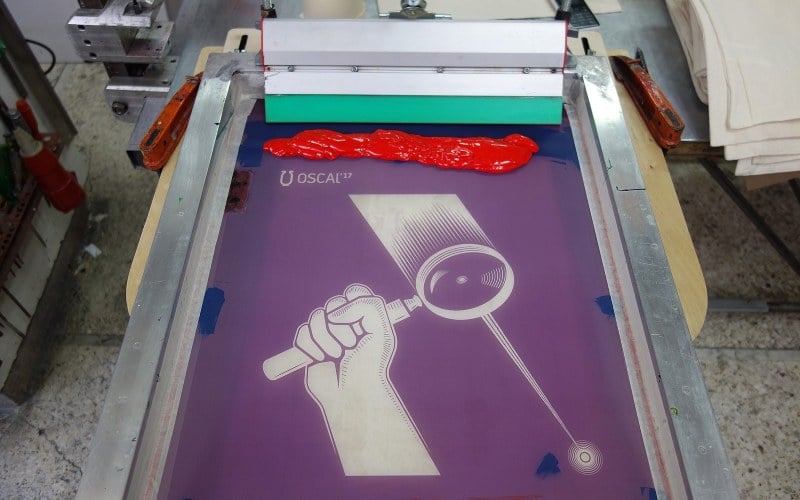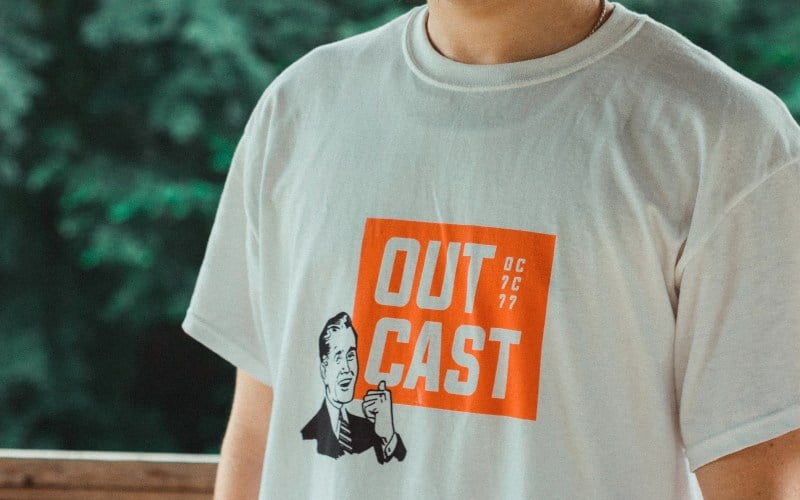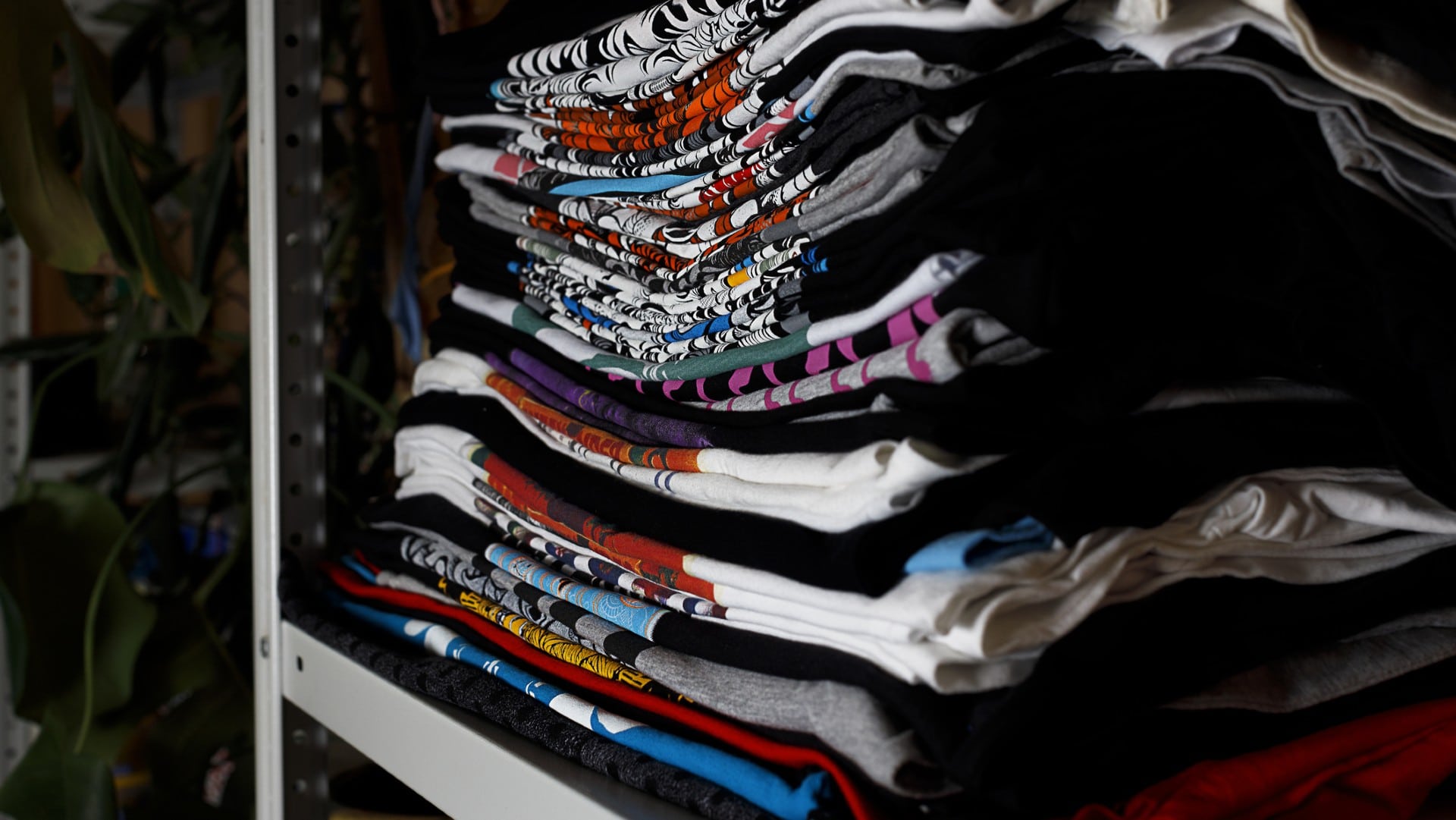With the current boom of popularity in customized t-shirts and other apparel, there is little wonder why small business owners are jumping on this trend. But with so many printing techniques and methods available, how do you know which one is right for you?
Screen printing requires minimal equipment to get started. Although vinyl is more expensive to set up, it can become more profitable than screen printing when made in small batches. Screen printing is more durable and versatile than vinyl but is more limited in its design freedom.
Screen and vinyl printing are two of the most popular methods to use for small businesses, and it’s not hard to see why. Both techniques come with their share of pros and cons, but there’s no denying that both of them are ideal for start-up business ventures and e-commerce vendors.
What Is Screen Printing?

Screen printing is a printing technique that allows you to transfer images onto fabric using a silk mesh screen and ink that has been specifically designed for fabric.
While you can commission a screen-printing business or company to help you bring your designs to life, screen printing can also be done at home – provided you have the right tools.
The mesh screen is usually positioned over a wooden frame, and the ink is then applied to the side of the frame facing you. Because the screen will already have a stencil of the design transferred onto it, the ink will stain your chosen image onto the fabric.
Pros Of Screen Printing

The 4 pros of screen printing include its versatility, superior quality, ability to manage large product batches, and simple learning curve.
1. Screen Printing Offers Versatility
Screen printing is one of the most versatile printing techniques you can do both at home and on a larger, commercial scale. The versatility of screen printing is generally a great advantage for small business owners or e-commerce vendors.
Screen printing allows you to print onto most flat surfaces, regardless of their material and works well on fabrics, plastics, and even wood.
So, if you’re starting a small printing business, you may want to invest in screen printing equipment. Because of its versatility, you will be able to expand your business over time without putting money into more expensive and unnecessary tools.
2. Screen Printing Offers Great Quality
Screen printing is known for its superior quality when it comes to the final product. It produces stunning, vibrant designs, which can be difficult to achieve through other printing techniques.
Because each color is individually layered onto the fabric, the colors can retain their hue perfectly. This makes it a great technique to use when producing colorful, eye-catching designs for t-shirts or hoodies. In fact, screen printing is most commonly used by small business owners to generate incredible original t-shirts with unique designs.
And, if you are using screen printing to design various types of apparel, you will find that the ink is resilient enough to withstand being washed without peeling or losing the overall design.
3. Screen Printing Is Ideal For Large Product Batches
If you are starting a small business, screen printing is one of the best printing techniques to use when getting started.
This is because screen printing equipment is relatively inexpensive compared to the tools needed for other types of printing. The equipment will generally only need to be set up once – no matter how many units of your product you are producing.
So, if you need to get a large order done, not only will screen printing save you money on the equipment, but it will save you time during the setup process, too.
4. Screen Printing Is Easy To Learn
When you’re looking to start a new business venture, choosing your particular product or niche can be difficult. Not to mention that you will want to find a way to start producing your product as quickly as possible to get your business off the ground.
If you want to get into printing, there are several different techniques that you could learn and master. However, screen printing is one of the few techniques with a relatively small learning curve.
Because of the simple tools and equipment you’ll need to start screen printing by hand, you’ll be able to produce your favorite designs in no time. Then all you need to do is watch your customers roll in!
Cons Of Screen Printing
The 3 cons of screen printing include its complicated setup, the limitations that this technique has, and that screen printing is not eco-friendly.
1. Screen Printing Is Complicated To Set Up
Although screen printing is easy and inexpensive, the setup process can be time-consuming. Once it has been set up, it is great for reproducing your design in large quantities, but the initial assembly can still be more complicated than other printing techniques.
Before you can transfer your designs onto your chosen material, you will first need to transfer your stencil onto a mesh screen. This process will need to be done with a new screen each time you add color or element to your overall design.
To achieve your final product, you will need to ensure that you have a good amount of supplies per product design.
2. Screen Printing Is Limiting
If you want to achieve a photorealistic design or a design that incorporates a lot of different colors, screen printing may not be the ideal technique for you or your business. It is also extremely difficult to achieve different gradients of color in your screen-printing design.
The more color that is incorporated into your design, the more money it will end up costing you. This is because of the number of screens you will need to realize your design in the long run.
There are also more steps involved in screen printing to create more complicated designs, which can be limiting in the images that you can print onto your chosen material.
3. Screen Printing Is Not Eco-Friendly
While there are a lot of environmentally friendly inks and screens on the market, these supplies will generally be more expensive to purchase. And, if you’re just starting, you may not have the capital to invest in more expensive equipment or tools.
The screen-printing process also uses a lot of water, which is generally used to wash your screens and mix your inks. For bigger batches, you will need to use more water. Similarly, the more complicated your design is, the more screens you need. Subsequently, this will lead to even more water being used for washing your screens.
What Is Vinyl Printing?

Vinyl printing is another popular printing technique that small business owners and e-commerce vendors commonly use. This technique is achieved through heat transference.
Using a design program and cutting machine, vinyl designs are printed and cut before they can be transferred onto your chosen material. The vinyl is then heat-pressed onto your fabric by way of both heat and applied pressure.
Pros Of Vinyl Printing

There are 4 pros of vinyl printing: being optimal for small-batch production, being customizable and versatile, and being easy to create.
1. Vinyl Printing Is Good For Small Production Batches
Sometimes starting a small business can be tricky. And while other printing techniques like screen printing allow you to make large batches of stock to keep on hand, you may not have the facilities or resources to make all of your products before your customer has purchased an item.
This is where vinyl printing comes in handy. Vinyl is great for making small batches of products, which means that you can use vinyl printing if your products are made to order. Because vinyl printing is relatively quick, your customers will also have a faster turnaround when compared to other printing techniques.
2. Vinyl Printing Is More Customizable
Because vinyl printing relies on printing your design out before you are able to transfer your design onto your chosen material, it is much more customizable than screen printing. Rather than having to layer each color or shape in your design, vinyl printing allows you to print your entire design out at once.
Similarly, there are a number of different design programs that you can use to create your vinyl designs. So, adding or removing color or elements is quick and easy.
You will also save yourself a lot of time and money by being able to see your design before transferring it to your fabric. With screen printing, you will only be able to see your entire design come together after every color and element has already been added.
With vinyl, you can see faults or design flaws once it has been printed and before it is transferred onto your product. This makes quality control much easier and can be time-saving when it comes to redesigning or trying out new designs.
3. Vinyl Printing Is Versatile
Another great advantage to vinyl printing is its versatility. You can place your design almost anywhere on your product, and you have a much wider color range to choose from.
Heat transferrable vinyl gives you much more freedom in terms of your final product because it is also able to reproduce photorealistic images and designs. Because you are able to print your design out, you will also be able to use a lot more color and include more elements into your design without any extra labor.
4. Vinyl Printing Is Easy To Create
Because vinyl is such a popular printing medium, there are tons of equipment and programs that you can use at home to get started. These programs simplify the design process, as working with digital elements is much less demanding than creating your design from scratch.
There also isn’t very much of a learning curve when it comes to using these programs. Most of them come with tutorials, and there are always tons of resources to draw from online.
Vinyl printing and cutting machines are also freely available to purchase, and there is one for every budget. So, if you’re starting your business with a smaller budget, you don’t need to worry – there are plenty of great options for you! And, as your business grows, you can always purchase bigger and better equipment!
Cons Of Vinyl Printing
There are 4 cons of vinyl printing, including its short lifespan, the feel of vinyl on various materials, its inability to produce large batches of stock, and the lack of vibrancy in your color palette.
1. Vinyl Printing Isn’t Durable
While vinyl printing may look fantastic, this printing technique isn’t as durable as some other methods. Because the vinyl sits on top of the fabric or material that you have chosen, it doesn’t adhere to the fabric as well as the ink may be.
If you have a vinyl-printed shirt or other apparel, you can lengthen the life of your clothes by washing them inside out and letting them air dry rather than using a tumble dryer. Apparel that has vinyl designs on it should also never be ironed.
Regardless of how well you look after your clothes, vinyl is prone to chipping and peeling over time. So, while your photorealistic design may be aesthetically appealing, it doesn’t have a long lifespan.
2. Vinyl Printing Can Be Stiff
Because vinyl plastic is rigid once it is placed onto fabric, you may notice that the clothing underneath your design feels stiff and uncomfortable. While this may not be a problem for some customers, others may not enjoy the sensation.
If your business offers vinyl printing, you will want to shop around and try some different types of vinyl. There are some soft feel vinyl products on the market that feel great to the touch.
3. Vinyl Printing Isn’t Good For Large Product Batches
While vinyl printing may be a great printing technique for start-up businesses, it is worth noting that it may not be a sustainable method to use in the long run. While vinyl printing has a quick turnaround for small batches, larger batches will take much more time.
This is because you will need to print, cut, and press a new design each time you want to create a product. If your orders supersede your ability to produce your products, you may struggle to meet your demand.
Additionally, vinyl can be an expensive material to purchase, which means that your expenses will inevitably rise with larger orders or batches.
4. Vinyl Printing Isn’t Vibrant
Unlike other printing methods, vinyl printing doesn’t always produce bright or vivid colors. It is also no possible to create color gradients using regular heat transfer vinyl.
Because of the dull color palette, vinyl printing is best used on lighter-colored apparel, which can limit the color range of your products as well. If you transfer vinyl onto a black t-shirt, for instance, the colors of your design may seem more faded because of vinyl’s inability to create a good contrast.
Screen Printing Vs. Vinyl Printing: Which Is Better?

When you’re starting a business, you’ll need to have a good idea of what kind of products you want to create. When it comes to designing and creating t-shirts and other apparel, there are a couple of different printing techniques that you can choose from. Two of the most popular types of printing are screen printing and vinyl.
Both of these techniques can be done on a larger scale through a big company or at home, if you’ve got the right equipment. But how do you know which printing technique is right for you and your business? As with most things, choosing between screen and vinyl printing will depend on your needs and personal preference.
Before you decide, we have come up with a simple side-by-side comparison to help you understand the main differences between the two printing techniques to make your decision easier.
| Screen Printing | Vinyl | |
| Equipment | Minimal equipment is needed to get started, but you may need more depending on your product range | More expensive equipment is needed, and vinyl materials can be expensive to purchase |
| Setup | Time-consuming and more complicated setup, but only one setup is required to produce large quantities of product | Easy to set up, but will need to be reset for each item you are printing |
| Durability | Can withstand multiple washes with no fading or chipping | Will fade, chip, or peel over time |
| Quantity | Good for large batches of stock | Good for small batches of stock |
| Versatility | It can be used to print on multiple surfaces and various materials | Not compatible with a wide range of materials |
| Design | Good for simple designs with minimal elements and a simple color palette | Offers more design versatility, and it is easier to edit or redesign your images |
Conclusion
So, there you have it. If you’re thinking of starting a small printing business, making decisions on the best printing method can be tough. But thanks to our guide, you can make a more informed decision based on your business’s needs.
Once you know which printing technique suits you, the only limit is your creativity.
Bryan E. Robinson is the former owner of TshirtGrowth. He has sold t-shirts since 2006 through dropshipping, screen printing, vinyl printing, DTG, Print on Demand, and more. Bryan has created his own t-shirt designs through Photoshop, Canva, and other platforms, as well as worked with freelancers to create many of his designs. Besides t-shirts, Bryan has over 18 years of experience in online marketing with eCommerce, B2B SaaS, B2C products, and more.


